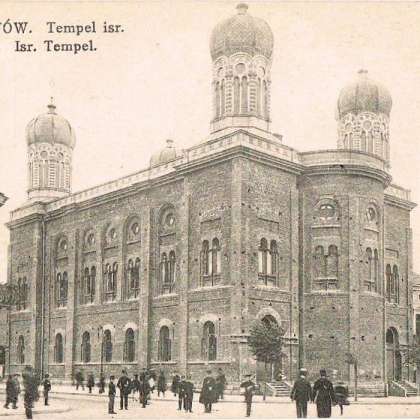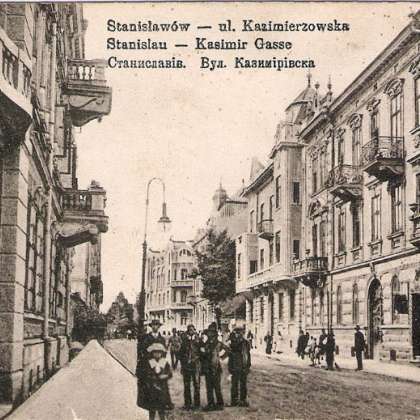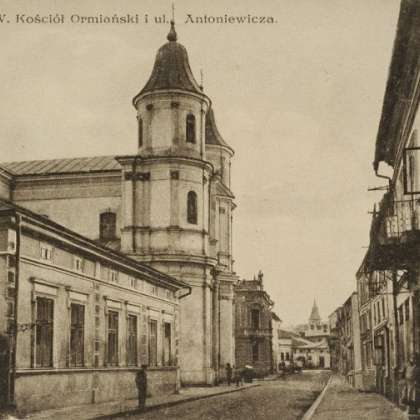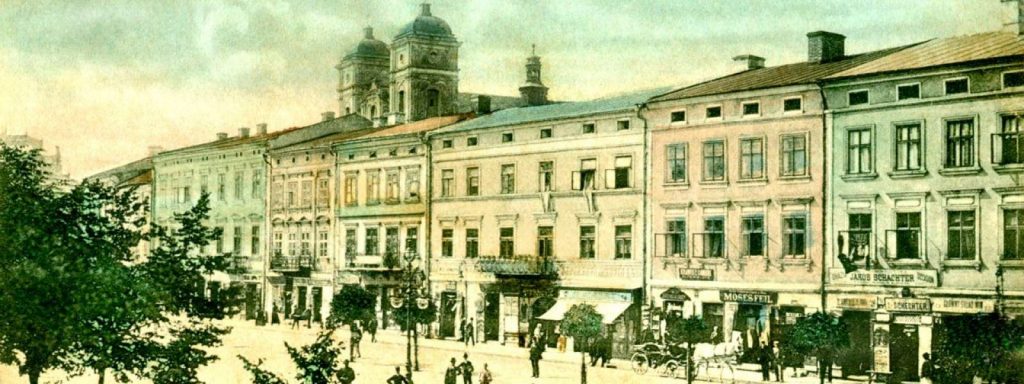“Together but practically separate”: How Ukrainians, Jews, and Poles lived in the “Happy Austro-Hungarian Empire”
Yuri Andrukhovych and Ivan Monolatii discuss the history of one Galician city.
Andriy Kobalia: Western Ukrainians are still nostalgic about the period when the stillness of the forests began to be disrupted by arriving trains, when the German language could often be heard in cities, and when Galicia and Cracow were together in one province and in one country, together with Venice and Vienna. This conversation is about the Habsburg Empire. Today we will be talking about the vestiges of Austrian Stanyslaviv in today’s Ivano-Frankivsk, the rivalry among Ukrainians, Jews, and Poles, and the memory of the ethnic mosaic that practically no longer exists.
The writer Yuri Andrukhovych told us about Austria-Hungary and Ivano-Frankivsk, topics that he explores in his texts.
Yuri Andrukhovych: My subjective feelings about the “happy Austro-Hungarian Empire” are above all on the personal and biographical level, because I grew up in the closest family milieu with my grandmother, Irena, who, one might say, was a child of Austria-Hungary. She was born in 1902, which was the “high stage of flowering” of this state entity. Some individual flashbacks came to me through her. For example, she remembered a grand duke driving down a street in a cabriolet with an escort in the city of Stanyslaviv. I fantasized later that he was not some grand duke but Franz Ferdinand himself, and that he was not traveling just anywhere but straight to Sarajevo, where he was shot. In reality, this was a different grand duke, but also a representative of the House of Habsburg who was on a military inspection. The press at the time wrote about this a lot. And the year 1909 fits ideally because she is almost a seven-year-old girl. Her memories were just as foggy as my impressions of her stories. But there is a kind of small bridge.
Andriy Kobalia: If we talk about this period and about contemporary Ivano-Frankivsk, which has a different name, what traces of this “happy era” remain in Ivano-Frankivsk?
Yuri Andrukhovych: Above all, this is architectonics. In recent times this has been violated by new construction, but the architectural elements of the second half of the nineteenth to early twentieth centuries, as well as the city planning of that period, have been preserved to this day in the historic part of the city; for example, the blend of a certain type of mansion with a garden extension that is adjacent to the building or behind it.
I think that the city has not been divested of this flair. I also think imprints also remain in the mentality of the local residents. But the problem is also that it is not just the name that changed but its population as well. I can consider myself a native because three generations of my family have been residents of this city. I don’t know where they came from before that. But there are only a few of this type of Ivano-Frankivsk, Stanyslaviv resident. This city experienced several waves of quite radical changes in population. That is why mentality is a contentious point, but one can speak of palpable vestiges in the language. Germanisms in the language of people in Ivano-Frankivsk point to the Austrian period.
Andriy Kobalia: Besides Stanyslaviv in these lands, there was Lviv, too, and in the crown land of Bukovyna there was Chernivtsi. I have noticed that the Austrian period made an impact on these cities in diverse ways. The rhythm of these cities is different.
Yuri Andrukhovych: Lviv was the capital of the Kingdom of Galicia and Lodomeria. This city performed a very particular function in these lands. It was a capital. Stanyslaviv preserved a certain provincialism and was third in importance after Lviv and Cracow. The residents of this city—with all their energy—mounted a soft resistance to its becoming a large metropolis. In this provincialism they had found a certain allure. Incidentally, this is a distinctive feature of the city’s current residents. They acknowledge their provincialism and are not embarrassed by it. I think this is wonderful because these people do not pretend to be other than who they truly are.
Andriy Kobalia: In your texts you write that, thanks to Austria-Hungary, the Ukrainian idea and the “Ukrainian component” survived in Europe.
Yuri Andrukhovych: Yes, I had in mind political freedoms, which were without a doubt severely limited in Austria-Hungary, but after the Revolution of 1848 very positive changes took place in the socio-political order. A constitutional monarchy and a parliament appeared. There was also the beginnings of the freedom of speech, freedom of belief, and basic citizen rights. That is why even in such a sphere as the emancipation of women, the fight for their rights, and expanding their rights, there were considerably better prospects in the Austrian-ruled lands than in the Russian-ruled lands.
If we talk generally about the possibility for Ukrainian cultural figures to express their views in their native language, to write, and to publish, again this is a different situation from the one in tsarist Russia. For that reason, many writers from Dnipro [River] Ukraine published their works here. A different situation existed in Transcarpathia. Even though it was part of Austria-Hungary, it was under the control of the Hungarian Crown, where the rights of Ukrainians were fundamentally restricted. Another reason why Galicia became the leader of the national awakening is that, in comparison with all of Ukraine’s historical regions, progress took place here under the most favorable circumstances.

Andriy Kobalia: Returning to the history of Ivano-Frankivsk, let’s mention that Galicia is not just about Ukrainian literature and Ukrainian voices. There have been, and perhaps still are, Polish and Jewish voices.
Yuri Andrukhovych: This is a big chunk of work that still needs to be researched. Not so long ago, when I was working on a new text, I became more deeply acquainted with materials relating to the Holocaust. In this city on “bloody Sunday” in October 1941, the Nazis shot up to twelve thousand Jews. This has been very well researched. Among those who were killed were some thirty poets, essayists, and writers. I think that it is the duty of the current residents of the city to restore this memory, because there were also several dozen artists and actors. This was an entire cultural stratum that emerged from the roots of the Austrian period, although I am talking about the Second World War, when no Austria-Hungary had existed for a couple of decades. We cannot simply forget about the phenomenon of Galician Jewry, with its distinctive cultural ambitions in a general European context. We don’t have the right to leave this unknown. So, let us place an ellipsis here…
Andriy Kobalia: In the early twentieth century Ukrainian-Polish-Jewish economic competition was observed in Galician cities. Ukrainian—often rural—enterprises tried to enter Galician cities, where most niches were already occupied. The historian Ivan Monolatii discussed the “unspoken rivalry” in a “country where everyone lived in peace but only tolerated each other.”

Ivan Monolatii: In my view, Ukrainians feared the city. Even though they were the ethnic majority in the region, they were afraid to come to the city with their trades and manufactured goods because the niches were often occupied by “foreign” Jews and Poles. By the way, in the cities, the Poles were also afraid of the Jews. There are very interesting interwar publications about Polish merchants and town residents of Stanyslaviv, unfortunately not yet translated into Ukrainian, which record that “people from the East have seized everything, both trade and crafts, and they are trying to occupy our life space.” At the beginning of the twentieth century we can speak of economic competition, which was also observed in Stanyslaviv.
Andriy Kobalia: Speaking of economic competition in the late nineteenth–early twentieth centuries, what were the methods of this competition? We know about boycotts. Were there some other radical instruments? Even pogroms? Was economic competition a peaceful struggle, for the most part, where people seek to foster the development of their business in a legal fashion?
Ivan Monolatii: I would call this an “unspoken rivalry” wherein people believed that you cannot go to a Jew and buy his goods. In the early twentieth century the Ukrainian cooperative movement becomes a very widespread and massive phenomenon. There was the slogan, “Our people go to our own for our products.” They went to their own. And they would also rather go to Christians than to Jewish merchants. This was the dividing line. This was observed in the interwar period. In the city itself there were no radical measures, no pogroms and killings. But there were incidents in the area around Stanyslaviv where Poles and Ukrainians, peasants, sought to confiscate agricultural equipment from Jews. It was rare, however, that there were Jewish farmers but there were cases. The conflict took the form of removing the means of production from Jews. Both Ukrainians and Poles engaged in this and there are very many court cases during this period.
Andriy Kobalia: Were there situational alliances in this competition? For Galicians in the nineteenth century was buying something from someone following a different religion “more sinful” than from a person of your own religion but different denomination?
Ivan Monolatii: There were no situational alliances in the economic sphere, but some could arise in the political sphere. For example, Polish politicians were very vexed by the existence of the Ukrainian-Jewish coalition of 1907 in elections to the parliament in Vienna. Ukrainians were urged to vote for Jews, and Jews—for Ukrainian candidate-deputies. There was mutual alienation in the economic sphere. At one time, the Jewish religious thinker and writer Martin Buber called Austria-Hungary a country where everyone lived in peace but only tolerated each other. I also often use in my publications the phrase, “Together but nearly separate,” when everything was generally fine in the empire, but in the Kingdom of Galicia and Lodomeria each nation lived and was creating its history individually. This was a struggle for scarce resources such as land. There was a struggle for political power in the cities.
During this period, of course, Jews and Poles predominated in most cities, including Stanyslaviv. Ukrainians were on the margins of general urban life. The urban cultural space in Stanyslaviv was created first and foremost by Polish and Jewish national societies. But there was no dialogue between them. Every nation, every community, lived separately and apart. We can hardly find any mention of Poles expressing sympathy for any Jewish community. There are only individual cases. I don’t think this was the fundamental reason, but this was one of factors that had a strong impact on the further conflict-ridden interaction later, during the antisemitism of interwar Poland and the first Soviet occupation of Western Ukraine at the beginning of the Second World War. The Jewish community, the historic Jewish community in our city, is lost in this cauldron and catastrophe.

Andriy Kobalia: Let’s leave local subjects pertaining to this one Galician city and look at the situation in a more global way. What were Vienna’s tactics concerning the Ukrainian (Ruthenian)-Polish-Jewish confrontation?
Ivan Monolatii: I think that here we are attributing great importance to the central government in Vienna and how they viewed Galicia in researching this chronotope. We are perhaps sometimes inflating our expectations in viewing Vienna’s reaction to these events. There were many regions like Galicia or Bukovyna in the multinational Austro-Hungarian Empire. There were problems between Germans and Czechs in Bohemia, and many other issues in other regions. In the case of the Jews, the empire wanted to turn them into cultural citizens of its own making. This policy envisaged Jewish ethnic self-renunciation in exchange for civil rights. According to the Constitution of 1867, all nations in the Austro-Hungarian Empire, all religions, all languages, were considered equal. And nationality was recognized—for everyone but the Jews. People had to identify themselves with the German-language, Polish-language, or—very rarely—Hungarian-language stream. In this context, such notions as “Poles of Moses’s faith” or “Germans of Moses’s faith” appear. We don’t find “Ukrainians of Mose’s faith, and this for me is very problematic. Thus one had to renounce one’s faith, and renounce one’s own self to some extent, to enter what the Habsburgs considered the “civilized society” of Austria-Hungary and become respectable and full-fledged citizens. This problem of acculturation and assimilation continued during the interwar period in Poland, where it was more advantageous to become a Pole than to be a Jew and thus acquire civic and political rights.
Andriy Kobalia: Austria-Hungary collapsed in the fall of 1918. Then a war breaks out between the ZUNR [Western Ukrainian National Republic] and the Second Rzeczpospolita. This is followed by an entirely different epoch. In talking about the “happy days,” are there any Jewish traces from that era left in today’s Ivano-Frankivsk? What are the sites of Jewish historical memory from that period in the city?
Ivan Monolatii: Are there any marked and visualized facts pointing to the Jewish presence in the city? I think not. Not even on the site of former wooden synagogues are there any markers that would indicate this. This is a question not just for the municipal government but to civil society as well. In my opinion, the dominant symbol is the progressive temple synagogue that was built in the late nineteenth century, which was known for its progressiveness. You could read the latest European newspapers there. This greatly annoyed the conservative Jewish population of the city, which thought: “Some sparrows have arrived in our city with French and German newspapers, and they’re reading them in the synagogues.”
Little attention is paid to the Jewish cemetery, which, in the words of Martin Pollack, has become a “poisoned landscape of the city.” In this place several tens of thousands of Jews were exterminated. The historic sights of Ivano-Frankivsk recall the historian Omer Bartov’s phrase “erased places,” although I question this American historian of Israeli background, because he often goes out of his way to single out the unattractive aspect of the ethnic majority’s attitude toward the Jewish population. I think that now is the right time for Ukrainian-Jewish cooperation in order to furnish these sites in Ivano-Frankivsk with a memorial discourse.
This program was made possible by the Canadian non-profit organization Ukrainian Jewish Encounter.
Originally appeared in Ukrainian (Hromadske Radio podcast) here.
Translated from the Ukrainian by Marta D. Olynyk.
Edited by Peter Bejger.
NOTE: The UJE does not necessarily endorse opinions expressed in articles and other materials published on its website and social media pages. Such materials are posted to promote discussion related to Ukrainian-Jewish interactions and relations. The website and social media pages will be places of information that reflect varied viewpoints.




















